For anyone interested in building one's own DMX devices, here is the Neutrik spec sheet on the connector in question, as used on the ETC Revolution: Neutrik - Industrial - A Series - NC5FAV-SW.Nope, that's the only one I've seen. Of course, ETC products are what I'm most familiar with, so that shouldn't be terribly surprising. As simple as it is, though, I'm sort of surprised it hasn't been a more popular feature. Especially since lack of termination is so frequently the cause of DMX problems.

The SmartPack uses this connector also, as evidenced in this statement:
from this document: http://www.etcconnect.com/docs/docs_downloads/manuals/SmartPack_Portable_SetupGuide.pdf.
Last edited:


